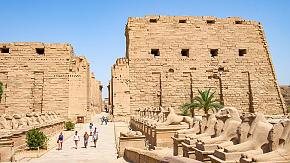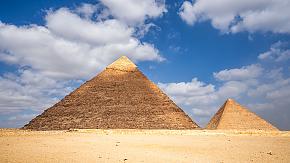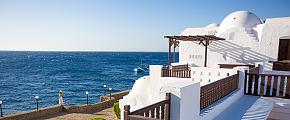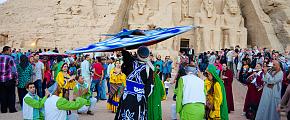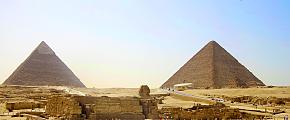In Search of the Pharaohs in Ancient Egypt
Egypt. One of the world's oldest still existing civilizations. Just the names Cleopatra, Ramses, Nefertiti and Tutankhamen evoke every childhood memory of fascinating stories. Pharaohs. Who doesn't know what they were? But most would struggle to say what kings were called in other countries thousands of years ago. And let's not forget mummies, the top attraction in so many museums around the world.
Think of the movies set in Egypt. Of course the 1963 movie Cleopatra starring Elizabeth Taylor remains popular and a huge part of western culture. Shakespeare's "Antony and Cleopatra" is still a popular play. Stories from the Bible resonate with Egypt, Moses and The Ten Commandments.
The Pyramids, of course. And the Sphinx. The Nile. This is undoubtedly a place seared in the imagination of millions, ever if they have never set eyes on it in real life. But, perhaps it's time to change that. A trip to Egypt gives a deeper understanding of all those stories while giving you memories which will last a lifetime.
But where to start?
The country owes its existence and survival to one thing – The Nile (Baḥr Al-Nīl in Egyptian Arabic). Most of the country is empty, inhospitable desert and so, 99% of the population live by the world's longest river which passes through nine other countries before reaching Egypt from its origins far to the south and finally emptying into the Mediterranean. With approximately 20% of the population living in greater Cairo, the capital, this is a must-see place for any visitor wanting to get to see the daily life of the people in Egypt - and it's close to the best pyramids making it an ideal base. But there is much more to this ancient land.
So let's start by taking a leisurely virtual tour upriver from Cairo to - well, let's see where.
CAIRO
Cairo is where the vast majority of visitors first land so is where most people's Egypt experience begins. To get more than just an insight into the culture of Ancient Egypt, I strongly suggest starting with the Egyptian Museum (Al-Matḥaf al-Miṣrī). This museum, founded in 1858 has over 100,000 exhibits covering the entire history of the Pharaonic period as well as the post Cleopatran Greco-Romanic period. They hold around 1,700 relics of Tutankhamen. This is where you can see his utterly astounding solid-gold death mask, among many other riches from Egypt's distant past – sarcophagi, jewelry, statues and more. A perfect introduction to a dream destination.
Address: Midan El Tahrir, Geographical Society Building, Cairo 11511.
Tel: +20 112 152 0515.
GIZA, PYRAMIDS AND THE SPHINX
Of course, no one sensible is going to visit Egypt and not see its most well-known attractions - the Pyramids of Giza and the nearby Sphinx. Giza lies about 7 km / 4½ miles from Cairo's city center, so is very accessible. The site includes three important pyramids built between around 2575 and 2465 BC, and includes the Great Pyramid which was the tomb of the Pharaoh, best known for his Greek name, Cheops, although in Egyptian it is Khufu. His pyramid, the largest in Egypt was originally 471 feet / 143 meters in height, but over the centuries it has not only been looted internally, but the exterior limestone covering has been mostly stolen reducing it to a mere 451.4 feet / 138 meters. The 5.75 million ton pyramid, assembled from over 2 million stones cut for the project nearly 5,000 years ago is truly a mysterious but grand human achievement and remained the tallest building in the world until modern times. To this day, although there are various theories as to how it was built, no one is absolutely sure. Herodotus, wrote centuries ago that the Great Pyramid took 20 years to and 100,000 men to build, but he was born 2,000 years after they were built, so we can't know how accurate he was.
 Pyramids and the Sphinx in Giza
Pyramids and the Sphinx in Giza
The two other surviving pyramids are somewhat smaller and were the tombs of the Pharaohs, Khafre and Menkaure. Sadly all the pyramids have had their treasures stolen and mostly lost, but their magic and allure remain. I suppose we are just lucky that they remain at all. The remaining treasures will be kept in the Grand Egyptian Museum about 2 km from the Pyramids.
Of course you won't want to leave Giza without stopping by to say "hello" to the Sphinx. This noseless statue of a lion with a man's face is equally mired in mystery. Some believe it was built for the Pharaoh Khafre whose pyramid is nearby, and it's his face that is depicted. He ruled between 2575 and 2465 BC. Others think it may be Cheops. Again, we'll probably never know. Whatever, despite being badly damaged, the 240 feet / 73 meters long and 66 feet / 20-meter high statue is another essential stop on any Egypt tour.
Other Cairo sites that are perhaps less well known include:
SALAH EL DIN CITADEL, MOHAMED ALI MOSQUE AND MORE
Getting a bit more modern, we come to Salah El Din Citadel, built in the 12th century by the famous leader, Salah El Din, also known as Saladin. Partly a military fortress and partly a royal palace complex, this citadel was the seat of government for over 700 years. The Mohamed Ali Mosque is a beautiful Ottoman-style wonder, built in the citadel between 1830 and 1849 and clad in marble.
 Mohamed Ali Mosque in Cairo
Mohamed Ali Mosque in Cairo
Qasr El-Jawhara is a more simple, two-story palace also known as the Jewel Palace. This was the site of the notorious massacre of the Mamluks or Slave Soldiers, who were invited to dinner and then slaughtered by Mohamed Ali's army.
Within the citadel there is also a museum depicting Egypt's military history from the earliest days up to the 20th century as well as the Carriage Museum containing the royal carriages.
Finally the citadel, perched on a hill offers stunning views over Cairo stretching all the way to the plains of Giza and the pyramids.
KHAN EL KHALILI BAZAAR
Before we leave Cairo, to get a thrilling insight to modern Egyptian life, we head to Khan El Khalili Bazaar. Said to be Egypt's most visited attraction, the bazaar is also believed the be the oldest open air market in the Middle East. It is more visited than even the pyramids, because it is visited daily by many Cairo's residents as well as the many tourists.
There has been a bazaar or market here since at least the 14th century, but the present site was mainly built in the 16th century. Today, the bazaar sells everything from gold and silver, through artisan crafts to clothing, jewelry, perfume, and of course food and spices. It is fascinating to stroll around, watching the locals happily haggling with the various vendors for their daily needs while visitors hunt for souvenirs.
Don't forget to stop off for a rest and drink an Egyptian-style coffee at one of the bazaar's many coffee shops. Most popular, and often very busy is Al-Fishawi Coffee Shop, which opened in 1773. The café, which has been open 24 hours, 7 days a week for centuries, can be found in El-Fishawi Alley and the building's interior is beautifully decorated with traditional, carved wooden walls.
Also, Khan El Khalili is the best place to try Hamam Mahshi bi Burghul, a traditional Egyptian dish of braised pigeons stuffed with bulgur, raisins, and pine nuts. Faharat restaurant is recommended by many locals and visitors.
It is worth noting that few of the traders here accept anything other than cash and that haggling is not only expected and encouraged, but part of the experience. Keep smiling. It is normal to end up at around one-third of the original asking price.
MEMPHIS
Memphis (the original one!) was the ancient capital of Egypt and was the home to many of the pharaohs, including Ramses I Ramses II, and Tutankhamen, and to the builders of the pyramids. Located 24 km / 15 miles south of Cairo, the remains of the city are considered an open air museum and has been listed by UNESCO as a World Heritage Site.
The city is dominated by a huge, 80-ton alabaster Statue of Ramses II and has numerous temple ruins dedicated to the god Ptah and various pharaohs. The Great Temple of Ptah, the god of creation, was once the most important in Egypt. In the north-west of the city, is Saqqara Necropolis built by the famous Egyptian architect Imhotep for pharaoh Djoser. Here is the oldest pyramid in Egypt, the four-sided Saqqara Step Pyramid, built in the 27th century BC. Memphis's proximity to Cairo means it is best visited as a day trip from the capital.
LUXOR
From Memphis and Cairo, we will embark on a trip down Egypt's most important traffic route, the River Nile, starting at Luxor. The cruise from here heading south covers the most important and interesting parts of the river and its banks. Known in Arabic as Al-Uqṣur, Luxor was originally part of the ancient city of Thebes. It lies on the east bank of the Nile. The Temple of Luxor was commissioned by Amenhotep III who reigned from 1390 to 1353 BC, but completed in the reign of Tutankhamen (1333 to 1323 BC), but added to and modified by later pharaohs. Actually a complex of various temples, despite being largely in ruins, it is still an impressive sight. Statues, obelisks, and sphinxes; halls, columns, and reliefs remain.
Also, in Luxor is the Temple of Karnak complex, the largest temple and second most visited historical site in Egypt, after the pyramids. Dedicated to the god, Amun-Re, this temple with its sandstone columns and huge statues, including the 10.5 meter / 34 foot tall statue of Pinedjem I (reigned 1070–1032 BC) is an essential stop for most visitors. Also, don't miss the 328-tonne, 29-meter / 95-foot obelisk, one of the biggest anywhere.
 Temples of Karnak in Luxor
Temples of Karnak in Luxor
On the opposite side of the Nile, are two of the most important archaeological sites in Egypt – The Valley of the Kings and the corresponding Valley of the Queens. The Valley of Kings is where many of the pharaohs and other nobles were buried in over 60 secret caves cut deep into the sides of the valley walls.
The tombs were found and looted centuries ago, but one remained relatively undisturbed until found again by the British archaeologist and Egyptologist, Howard Carter in November 1922. This is of course the tomb of Tutankhamun and for ten years after it was re-found, Carter and his team cleared it of its treasures which are now in the museum in Cairo. Despite the large number of treasures found here, Tutankhamun was a relatively minor figure and it is believed that some of the other tombs would have originally held much more.
The nearby Valley of the Queens (Wādī al Malekāt) is where the pharaohs' wives and daughters were entombed. Around 100 tombs exist, but most are relatively simple. These too were stripped of any valuables long ago.
Incidentally, one important tomb has never been found despite intensive searches over the centuries – that of Antony and Cleopatra, who were recorded as having been buried together. It was not here, however, but somewhere near Alexandria in the north of the country.
From Luxor, we can head south going upstream on the Nile to Aswan, but first stopping off at
EDFU – TEMPLE OF HORUS
Edfu is a small city on the west bank of the river, and home to the Temple of Horus (also known as the Temple of Edfu), the best-preserved and second-largest ancient temple in Egypt after Karnak. Built between 237 and 57 BC, the near intact temple was preserved by being abandoned in 391 AD, then buried under drifting sand dunes and silt carried by the river, before being rediscovered in 1860 by a French Egyptologist. The architecture and decorative reliefs are prime example of Egyptian art in the Ptolemaic period. You can almost imagine Cleopatra, the last Ptolemaic ruler, strolling through its halls to worship Horus, God of the Sky.
ASWAN
Aswan is a city on the east bank of the Nile, 684 kilometers / 425 miles south of Cairo, and our stopping point on this virtual trip. Nile riverboats ply their way from here to Luxor and back regularly. The area around Aswan is where most of the stone used in building the pyramids, various temples, statues obelisks etc around Egypt was quarried, then shipped along the river to where it was needed.
The most popular tourist destination here is Elephantine, an island in the Nile that forms part of the city. The most romantic way to visit the island is to take a traditional felucca (sailboat) trip from the main part of the city. Here you can visit the Aswan Museum, which contains many ancient artifacts as well as a rare mummified ram. Beside the museum is one of two ancient nilometers on the island, used to measure the depth of the river in flood season. From the museum there are 90 steps leading down to the river marked with numerals in Arabic, Roman, and Egyptian Hieroglyphic scripts. At the foot, there are several ancient inscriptions carved into the rocks.
 Feluccas sailing on the Nile
Feluccas sailing on the Nile
Horticulture lovers may also want to visit the Aswan Botanical Gardens on neighboring el Nabatat Island. The garden features many trees offering shade as well as beautiful flower displays and is home to a number of birds. The Garden is open from 8 am until 5 pm from October to April and from 8 am until 6 pm from May to September.
This completes our visit to Egypt for this time. There is much more to do in this fascinating country, such as visiting the Red Sea coast, taking a camel ride in the desert or visiting Alexandria, the second largest city. Remember, Odynovo can custom-make your tour to Egypt, including a Nile cruise, taking in all your preferences. Just tell us where you want to go and what you want to see and we'll get back to you within 24 hours with a free itinerary.
Quick Question
What Our Clients Say
Explore the latest verified reviews of Odynovo's travel services on Tripadvisor, Google, Trustpilot, Product Review and more trusted platforms.
SUBSCRIBE TO WIN A FREE TOUR
Subscribe to our newsletter for a chance to win a free 7-day tour to India! And more insider travel news, exclusive offers, and inspiration will be sent straight to your inbox. Check our previous newsletters and get some sparks.

